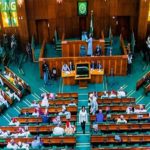As Nigerians continue to mount pressure on the Federal Government over its borrowing pattern, the International Monetary Fund (IMF) has called on policymakers to strike the right balance in the face of high debt and rising inflation, putting the global debt figure at $226 trillion.
The IMF said in 2020, it observed the largest one-year debt surge since World War II, with global debt rising to $226 trillion as the world was hit by a global health crisis and a deep recession.
Debt, it noted, was “already elevated going into the crisis, but now governments must navigate a world of record-high public and private debt levels, new virus mutations, and rising inflation.”
According to the latest update of the IMF’s Global Debt Database, global debt rose by 28 percentage points to 256 per cent of GDP, in 2020.
“Borrowing by governments accounted for slightly more than half of the increase, as the global public debt ratio jumped to a record 99 per cent of GDP. Private debt from non-financial corporations and households also reached new highs.
“Debt increases are particularly striking in advanced economies, where public debt rose from around 70 per cent of GDP, in 2007, to 124 per cent of GDP, in 2020. Private debt, on the other hand, rose at a more moderate pace from 164 to 178 per cent of GDP, in the same period,” the IMF said.
The Fund added that public debt now accounts for almost 40 per cent of total global debt, the highest share since the mid-1960, stressing that “the accumulation of public debt since 2007 is largely attributable to the two major economic crises governments have faced – first the global financial crisis, and then the COVID-19 pandemic.”
The IMF explained that debt dynamics differ markedly across countries, pointing out that advanced economies and China accounted for more than 90 per cent of the $28 trillion debt surge in 2020.
These countries, the fund explained were able to expand public and private debt during the pandemic, “thanks to low-interest rates, the actions of central banks (including large purchases of government debt), and well-developed financial markets. But most developing economies are on the opposite side of the financing divide, facing limited access to funding and often higher borrowing rates.”
The IMF said emerging markets and low-income developing countries faced much tighter financing constraints, but with large disparities across countries.
“China alone accounted for 26 per cent of the global debt surge. Emerging markets (excluding China) and low-income countries accounted for small shares of the rise in global debt, around $1-$1.2 trillion each, mainly due to higher public debt.
“Nevertheless, both emerging markets and low-income countries are also facing elevated debt ratios driven by the large fall in nominal GDP in 2020.
“Public debt in emerging markets reached record highs, while in low-income countries it rose to levels not seen since the early 2000s when many were benefiting from debt relief initiatives.
“The large increase in debt was justified by the need to protect people’s lives, preserve jobs, and avoid a wave of bankruptcies. If governments had not taken action, the social and economic consequences would have been devastating. But the debt surge amplifies vulnerabilities, especially as financing conditions tighten.”
YOU SHOULD NOT MISS THESE HEADLINES FROM NIGERIAN TRIBUNE
FALSE! Yoruba Not An Official Language In Brazil
Claim: A national newspaper and multiple online platforms claim Brazil has adopted Yoruba as its official language and that the language would be included in primary and secondary schools curriculum.
Verdict: The claim is false. The content of the article published by these online platforms is not new; it has been recirculated several times and has been debunked.






